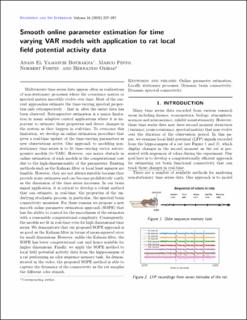| dc.contributor.author | El Yaagoubi Bourakna, Anass | |
| dc.contributor.author | Pinto-Orellana, Marco Antonio | |
| dc.contributor.author | Fortin, Norbert | |
| dc.contributor.author | Ombao, Hernando | |
| dc.date.accessioned | 2023-11-09T08:11:18Z | |
| dc.date.available | 2023-11-09T08:11:18Z | |
| dc.date.created | 2023-06-19T14:51:48Z | |
| dc.date.issued | 2023 | |
| dc.identifier.citation | Statistics and its Interface. 2023, 16 (2), 227-257. | en_US |
| dc.identifier.issn | 1938-7989 | |
| dc.identifier.uri | https://hdl.handle.net/11250/3101551 | |
| dc.description.abstract | Multivariate time series data appear often as realizations of non-stationary processes where the covariance matrix or spectral matrix smoothly evolve over time. Most of the current approaches estimate the time-varying spectral properties only retrospectively – that is, after the entire data has been observed. Retrospective estimation is a major limitation in many adaptive control applications where it is important to estimate these properties and detect changes in the system as they happen in real-time. To overcome this limitation, we develop an online estimation procedure that gives a real-time update of the time-varying parameters as new observations arrive. One approach to modeling non-stationary time series is to fit time-varying vector autoregressive models (tv-VAR). However, one major obstacle in online estimation of such models is the computational cost due to the high-dimensionality of the parameters. Existing methods such as the Kalman filter or local least squares are feasible. However, they are not always suitable because they provide noisy estimates and can become prohibitively costly as the dimension of the time series increases. In our brain signal application, it is critical to develop a robust method that can estimate, in real-time, the properties of the underlying stochastic process, in particular, the spectral brain connectivity measures. For these reasons we propose a new smooth online parameter estimation approach (SOPE) that has the ability to control for the smoothness of the estimates with a reasonable computational complexity. Consequently, the models are fit in real-time even for high dimensional time series. We demonstrate that our proposed SOPE approach is as good as the Kalman filter in terms of mean-squared error for small dimensions. However, unlike the Kalman filter, the SOPE has lower computational cost and hence scalable for higher dimensions. Finally, we apply the SOPE method to local field potential activity data from the hippocampus of a rat performing an odor sequence memory task. As demonstrated in the video, the proposed SOPE method is able to capture the dynamics of the connectivity as the rat samples the different odor stimuli. | en_US |
| dc.language.iso | eng | en_US |
| dc.publisher | International Press | en_US |
| dc.title | Smooth online parameter estimation for time varying VAR models with application to rat local field potential activity data | en_US |
| dc.type | Peer reviewed | en_US |
| dc.type | Journal article | en_US |
| dc.description.version | publishedVersion | en_US |
| cristin.ispublished | true | |
| cristin.fulltext | original | |
| cristin.qualitycode | 1 | |
| dc.identifier.doi | https://dx.doi.org/10.4310/22-SII729 | |
| dc.identifier.cristin | 2155922 | |
| dc.source.journal | Statistics and its Interface | en_US |
| dc.source.volume | 16 | en_US |
| dc.source.issue | 2 | en_US |
| dc.source.pagenumber | 227-257 | en_US |
